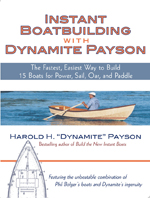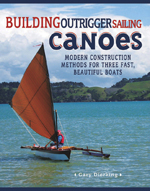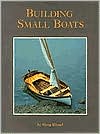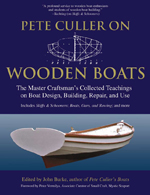
Over the centuries boatbuilding terms have become an integral part of our vocabulary–although the origins may be obscure. Our familiar word room started off as röm–the distance between rowing stations on a Viking ship. It’s discouraging for the novice to come across such words as scantlings, tumblehome or bearding line and then is told to fair the garboard strake into the stem rabbet. So it’s a sign of the times (and the market) that these new boatbuilding books are written in non-technical language and usually include glossaries explaining the more arcane terms.
Gavin Atkin: Ultrasimple Boatbuilding,
International Marine/McGraw-Hill, Camden, Maine
234 pages. $24.95, ISBN 9780071477925
This is a good book for the raw beginner because it assumes no previous experience. All you need in the way of tools is a hammer, handsaw, drill and tape measure. Since the time involved is short—a couple of weekends—and the boats small, they could very well be built in a living room (or even a bedroom) if no other covered space is available.
The author designed each of the 17 hulls to be built with plywood using solid wood only for trim, chines and rubbing strips. Dimensioned diagrams are provided (inches and metric) for each part so it’s easy to make full-size patterns before laying them out on plywood.
Atkin suggests making a scale model of the boat you plan to build so you get a preview of the inside shape and the amount of bend in the plywood.
These boats make no claim to elegance–-in fact some could double as a sandbox—but it’s a good place to start and will get you out on the water soonest. As your skills (and ambitions) develop you can take on more challenging projects.
Recommended.
Harold Payson: Instant Boatbuilding.
International Marine/McGraw-Hill, Camden, Maine
193 pages, $19.95, ISBN 9780071472647
Mr. Payson is best known for popularizing the ‘stitch and glue’ method of building plywood boats. This system involves joining plywood panels edge to edge with wire ties (the ‘stitches’) and then reinforcing the Connection with fiberglass tape and epoxy. This skips the tedious step of attaching the plywood to solid wood strips known as ‘chine logs’.
Payson teamed up with the distinguished designer Phil Bolger to produce plans for 15 boats. These range from an 8-foot pram dinghy to a 15-foot sail boat with another dozen boats–sail, motor and oar–in-between. All are made of plywood and can be car-topped.
As in Atkins’ book the plywood shapes are shown fully dimensioned so there is no need to loft the boat (enlarging the plans to full-size). Payson encourages the novice builder to build a scale model first and I would do the same.
Phil Bolger’s drawings are, of course, excellent but have been reduced in size so the figures are barely legible to the naked eye. My first step would be to enlarge the chosen plans 200% on a copier. The photos are small and somewhat muddy but mostly help clarify the text.
Well recommended.
Gary Dierking. Building Outrigger Sailing Canoes.
International Marine/McGraw-Hill, Camden, Maine
170 pages, $22.95, ISBN 9780071487917
We are greatly indebted to native builders around the globe for the elegant, practical workboats they have developed over the centuries. The ancient traditions of the Eskimo kayak, the birch bark canoe and
the Viking Faering have all continued their evolution into the 21st century albeit using modern materials and techniques. Outrigger sailing canoes are less familiar to us in North America but have also evolved through several millennia into fast, seaworthy craft able to navigate long distances and pass safely through the surf-girt islands of the Pacific.
Gary Dierking’s new book is an excellent way to get acquainted with these unique craft. He presents three of his designs based on Hawaiian traditions: the Ulua, Tamara 2, both 17′-9″ and the Wa’apa which is 23′-8″ long.
Dierking offers a choice of building methods: plywood, fiberglass, a foam-core sandwich and strip planking. Fastenings can vary from the traditional rope or synthetic lashings to metal or wooden pegs and pins. There are also several different styles of rig to choose from according to where and how the boat is to be used. Dierking suggests the builder adjusts the overall length of the hull to suit local conditions and available transport.
I found the book readable, well organized and the many drawings and diagrams are clear and complete. These are complicated and demanding craft which handle quite differently from monohulls. I would take the time to fully educate myself before undertaking to build one.
Well recommended.
These next two books cover a great deal of ground and I wish they had been around when I built my first boat 40 years ago.
Greg Rössel: Building Small Boats.
International Marine/McGraw-Hill, Camden, Maine
278 pages, $39.95, ISBN 9780937822500
Building Small Boats takes the reader through all the steps in building a boat planked in solid wood, lapstrake or carvel. Rössel writes for the eager, intelligent woodworker but assumes little or no previous experience. He treats the anatomy of a bench plane, sharpening techniques, even the intricacies of lofting with the same concise, easy-to-read style. The text is supplemented by excellent drawings and photos.
Of particular interest is chapter 23–‘What looks good’ the aesthetics of boatbuilding. Why some craft have a natural elegance and others look like ‘varnished milk cartoons’ to use Gregg’s phrase. Sheerlines, placement of fastenings and fittings, tapering risers, beading and cambers are all discussed with experience and perception. If you are planning to build a small, traditional, solid-wood boat this is the only book you will need.
Highly recommended.
Greg Rössel: The Boatbuilders Apprentice.
International Marine/McGraw-Hill, Camden, Maine
342 pages, $39.95, ISBN 9780071464055
The core of this book is a collection of 16 articles previously published in major boating magazines in the U.S. and the U.K. They have been brought together in this book, with minor editing but inevitably there is some duplication. Also the quality and style of drawings varies greatly and the photos range from excellent, clear and sharp to marginally useful.
Rössel covers all the major construction techniques (except cement!) solid wood lapstrake and carvel, batten seam construction, strip planking, plywood, stitch and glue, glued plywood lapstrake and cold-molding. The last two are only a couple of pages long so serve as brief introductions. He also has sections on organizing the shop, lofting, tools and much more. Section (4) Boats to Build, has much sensible advice for the novice boatbuilder on choosing the right boat.
There is a lot of useful information in this book and I would keep it in the shop for reference when needing to inform myself on some specific subject. Oarlocks, for example, lofting, bending with steam or whatever. The book has a comprehensive index (page numbers in bold indicate illustrations) and also a glossary.
Well recommended.
Pete Culler: Pete Culler on Wooden Boats
International Marine/McGraw-Hill, Camden, Maine
386 Pages, $29.95, ISBN 9780071489799
Pete Culler was among the last generation to acquire the inherited skills of generations of shipwrights. In 1929, while still an apprentice at the Alonzo Conley shipyard in Maryland, he began building a replica of Joshua Slocum’s famous yawl ‘Spray’. In 1951 he sold Spray and a acquired a larger vessel, Rigadoon, for his growing charter business. The vessel was wrecked in the 1954 hurricane and Culler turned his attention to boat design. By the mid 1960s he had become one of the foremost designers of wooden boats, everything from 14 foot skiffs to an 82 foot schooner. His design philosophy –simplicity, economy and ease of use–never changed and by the time of his death in 1978 he had produced several hundred designs, most of which are still available and many still being built.
Pete Culler was that rare combination that not only knows his subject inside out but can write about it with grace and humour. The present book is a collection of his writings including excerpts from his two books, Skiffs and Schooners and Boats Oars and Rowing, as well as a dozen articles and design commentaries.
This is a book not just for the wooden boat crowd but for anyone interested in an ancient, traditional craft that is right on the fringe of living memory. There is a wealth of sometimes arcane but always fascinating information in this book–where else could you get a recipe for making tallow (mutton fat is preferable to beef) or the mysteries of pine tar? Pete Culler is not shy about epressing his opinions but it’s always informed, relevant and considered.
I can’t recommend this book too highly.













